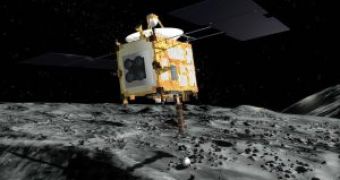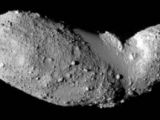A small, near-Earth asteroid named Itokawa is just a pile of floating debris, probably created from the breakup of an ancient planet, according to a University of Michigan researcher who was part of the Japanese space mission Hayabusa. The finding suggests that asteroids created from rubble would be pristine records of early planet formation.
Daniel Scheeres, U-M associate professor of aerospace engineering, was part of the team that determined the asteroid's mass, surface environment, and gravitational pull, and helped interpret the images that were taken of the asteroid from the spacecraft.
The Hayabusa space probe arrived at asteroid Itokawa last fall and orbited for three months. During that time it descended twice to the surface of the asteroid, which is named for the father of Japanese rocketry, to collect samples. In 2010 the probe will return to Earth and eject a sample canister that will reenter the atmosphere and land in central Australia. Researchers hope this will be the first asteroid sample brought back to Earth.
Scheeres said that the confirmation of Itokawa's makeup as rubble rather than a single rock has large implications for theories of how asteroids evolved, and will lead to a better understanding of the early solar system. Asteroids are thought to be the remnants of material that formed the inner planets, which include Earth, and could bear the record of events in the early stages of planet formation. It is a significant finding that Itokawa is a pile of rocks ranging in size from tiny sand grains all the way up to boulders 50 meters wide, because it verifies a number of theories about the makeup and history of asteroids.
The existence of very large boulders and pillars suggests that an earlier "parent" asteroid was shattered by a collision and then re-formed into a rubble pile, the researchers conclude in the paper. It's likely that most asteroids have a similar past, Scheeres said. "Analysis of the asteroid samples will give us a snapshot of the early solar system, and provide valuable clues on how the planets were formed."
Also, knowing if an asteroid is a single, big rock or a pile of rubble will have a major influence on how to nudge it off course if it would come towards Earth. An asteroid collision with Earth, while unlikely, could have disastrous consequences.
Another striking finding is that regions of Itokawa's surface are smooth, "almost like a sea of desert sand" and others are very rugged. This indicates that the surfaces of asteroids are, in some sense, active, with material being moved from one region to another. Gravity holds the mass of rubble together. "These are the first such detailed observations of an asteroid from this close," Scheeres said.

 14 DAY TRIAL //
14 DAY TRIAL // 
